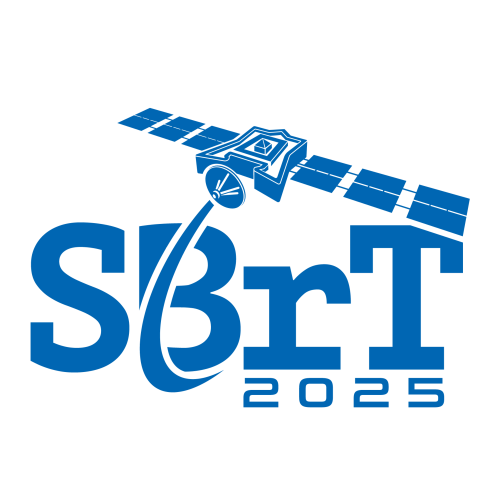
XLIII Simpósio Brasileiro de Telecomunicações e Processamento de Sinais
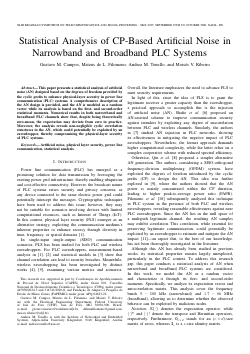
Statistical Analysis of CP-Based Artificial Noise in Narrowband and Broadband PLC Systems
Gustavo M Campos, Mateus Filomeno, Andrea M Tonello, Moises Vidal Ribeiro
DOI: 10.14209/sbrt.2025.1571145548
Keywords: Artificial noise Physical layer security Power line communication Statistical analysis
Abstract
This paper presents a statistical analysis of artificial noise (AN) designed based on the degrees of freedom provided by the cyclic prefix to enhance physical-layer security in power line communication (PLC) systems. A comprehensive description of the AN design is provided, and the AN is modeled as a random vector while its analysis is based on the first- and second-order statistical moments. Numerical results in both narrowband and broadband PLC channels show that, despite being theoretically zero-mean, the expectation may deviate from zero in practice when the number of realizations is low. Moreover, the analysis reveals non-negligible cyclic correlation structures in the AN, which could potentially be exploited by an eavesdropper, thereby compromising the physical layer security of PLC systems.Download
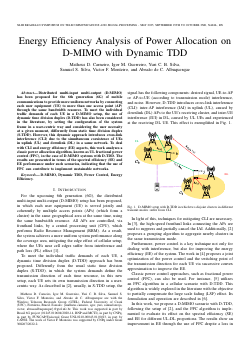
Energy Efficiency Analysis of Power Allocation on D-MIMO with Dynamic TDD
Matheus D. Carneiro, Igor M. Guerreiro, Yuri C. B. Silva, Samuel S Silva, Victor Farias Monteiro, Abraão de Carvalho Albuquerque
DOI: 10.14209/sbrt.2025.1571145616
Keywords: D-MIMO Dynamic TDD Power Control Energy Efficiency
Abstract
Distributed multi-input multi-output (D-MIMO) has been proposed for the 6th generation (6G) of mobile communications to provide more uniform networks by connecting each user equipment (UE) to more than one access point (AP) through the same bandwidth resource. To meet the individual traffic demands of each UE in a D-MIMO setup, the use of dynamic time division duplex (D-TDD) has also been considered in the literature, by setting the configuration of the system frame in a user-centric way and considering the user necessity at a given moment, differently from static time division duplex (S-TDD). However, this dynamic approach introduces cross-link interference (CLI) due to the simultaneous coexistence of UEs in uplink (UL) and downlink (DL) in a same network. To deal with CLI and energy efficiency (EE) aspects, this work analyzes a classic power allocation algorithm, known as UL fractional power control (FPC), in the case of D-MIMO systems with D-TDD. The results are presented in terms of the spectral efficiency (SE) and EE performance under such scenarios, indicating that the use of FPC can contribute to implement sustainable networks.Download

How Many Transmission Reception Points to Deploy in a User-Centric Distributed Massive MIMO Network?
Juan Fabricio Monteiro Oliveira, André Fernandes, Daynara Dias Souza, Yasmim K. C. Costa, Andre Mendes Cavalcante, Joao Weyl Costa
DOI: 10.14209/sbrt.2025.1571145681
Keywords: Cell-free massive MIMO User-centric networks TRP dimensioning 6G mobile networks
Abstract
User-centric distributed massive multiple-input multiple-output (D-mMIMO), or cell-free massive MIMO, is a novel wireless technology that improves spectral efficiency and provides uniform coverage in sixth-generation mobile networks (6G). However, properly dimensioning the amount of transmission and reception points (TRPs) for effective network operation is still a challenge. Unlike traditional cellular systems, the user's equipment can connect to multiple TRPs, leading to dynamic connections. This paper presents a methodology to estimate the minimum number of TRPs required in UC D-mMIMO systems, considering realistic user distribution and TRPs' unique coverage constraints. Results are presented for downtown and residential urban scenarios.Download
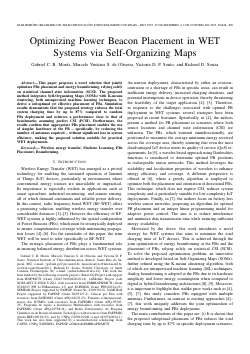
Optimizing Power Beacon Placement in WET Systems via Self-Organizing Maps
Gabriel C R Morás, Marcelo Satyro, Victoria Souto, Richard Demo Souza
DOI: 10.14209/sbrt.2025.1571145822
Keywords:
Abstract
This paper proposes a novel solution that jointly optimizes PBs placement and energy beamforming, relying solely on statistical channel state information (SCSI). The proposed method integrates Self-Organizing Maps (SOMs) with K-means clustering, both unsupervised machine learning techniques, to derive a suboptimal yet effective placement of PBs. Simulation results demonstrate that the proposed strategy reduces the total system charging time by up to 87% compared to random PBs deployment and achieves a performance close to that of benchmarks assuming perfect CSI (PCSI). Furthermore, the results confirm that appropriate PBs placement enables the use of simpler hardware at the PB -- specifically, by reducing the number of antennas required -- without significant loss in system efficiency, making the proposed solution suitable for practical WET deployments.Download
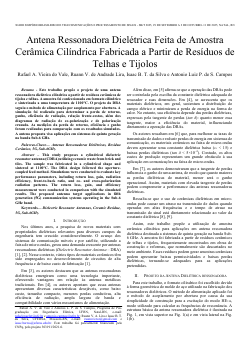
Antena Ressonadora Dielétrica Feita de Amostra Cerâmica Cilíndrica Fabricada a Partir de Resíduos de Telhas e Tijolos
Rafael Alex Vieira do Vale, Ruann Lira, Isaac B. T. da Silva, Antonio Campos
DOI: 10.14209/sbrt.2025.1571146057
Keywords:
Abstract
Este trabalho propõe uma antena ressoadora dielétrica cilíndrica a partir de resíduos cerâmicos de tijolos e telhas. A amostra foi confeccionada em formato cilíndrico e sinterizadas a temperaturas de e 1100 °C. O projeto da DRA seguiu o método de alimentação por acoplamento por abertura. A simulação foi realizada para determinar a perdas de retorno, ganho, eficiência de radiação, relação frente-costas, além dos diagramas de radiação co-polarização e com polarização cruzada. A medição da perda de retorno foi realizada para comparação com resultado simulado. As antenas propostas visam aplicações em sistemas de quinta geração na banda Sub-6 GHz.Download
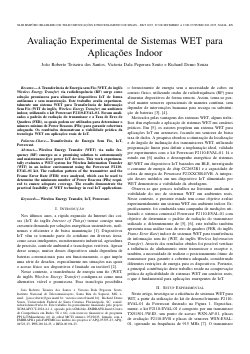
Avaliação Experimental de Sistemas WET para Aplicações Indoor
João Roberto Teixeira dos Santos, Victoria Souto, Richard Demo Souza
DOI: 10.14209/sbrt.2025.1571146402
Keywords:
Abstract
Wireless Energy Transfer (WET) via radio frequency (RF) emerges as a promising solution to autonomously and maintenance-free power IoT devices. This work experimentally evaluates a WET system for Wireless Information Transfer (WIT) in an indoor environment using the Powercast P2110-EVAL-01 kit. The radiation pattern of the transmitter and the Frame Error Rate (FER) were analyzed, which can be used to determine the minimum number of Power Beacons (PBs) required to ensure adequate coverage. The results demonstrate the practical feasibility of WET technology in real IoT applications.Download

Deep Learning-based Channel Predictor for RIS-assisted NOMA
Eduardo Francisco Silva de Lima Henriques, Rafael Chaves, Paulo S R Diniz
DOI: 10.14209/sbrt.2025.1571148485
Keywords: NOMA RIS Channel Estimation Deep Learning
Abstract
This paper explores the integration of non-orthogonal multiple access (NOMA) and reconfigurable intelligent surfaces (RIS) as key technologies to address the wireless communications challenges. NOMA improves spectral efficiency by enabling resource sharing among multiple users, while RIS enhances signal quality and coverage with lower energy consumption. However, this integration introduces complexity and non-linearity in channel estimation. To tackle this, we employ deep learning (DL) models, specifically convolutional neural networks (CNN) and long short term memory (LSTM) networks, to improve channel state prediction. Our main contribution is a new DL model with additional layers for more accurate magnitude and phase prediction. Simulations demonstrate that the proposed model reduces average inference time by 17%, decreases the number of training parameters by over 35%, and showcases signal-to-noise ratio (SNR) gains for fixed bit-error rate (BER).Download

Deep Bi-LSTM Detection for FTN-GFDM in Underserved Communication Scenarios
Mariana Mello, Karine Barbosa Carbonaro, Luciano Leonel Mendes
DOI: 10.14209/sbrt.2025.1571148631
Keywords:
Abstract
This work proposes a deep Bi-LSTM for symbol detection in FTN-GFDM systems. The estimator learns the nonlinear mapping between matched filter outputs and transmitted symbols, handling ISI and colored noise. The network is trained offline using synthetically generated data and evaluated over AWGN and TIFS channels. Results show that the Bi-LSTM achieves competitive BER performance compared to the SD, while offering fixed and low complexity during inference, making it suitable for real-time and resource-constrained applications.Download

Emprego de Redes Neurais Artificiais combinadas com Algoritmos Genéticos na detecção de intrusões em redes de computadores
Heitor Eugênio Gonçalves, Gabriel A Queiroz, Éderson R. da Silva
DOI: 10.14209/sbrt.2025.1571148975
Keywords:
Abstract
Neste trabalho, propõe-se uma técnica que combina Redes Neurais Artificiais (RNAs) e Algoritmos Genéticos (AGs) para a detecção de intrusões em redes de computadores. Para a validação da metodologia, foi utilizado o banco de dados CIC-IDS2018, que contém registros detalhados de tráfego de rede durante a realização de diversas intrusões. A aplicação da combinação dessas técnicas resultou em uma acurácia de 99,78\% na identificação de intrusões, demonstrando a eficácia e robustez da proposta na detecção de ameaças em ambientes de rede.Download
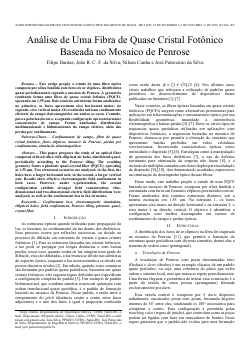
Análise de Uma Fibra de Quase Cristal Fotônico Baseada no Mosaico de Penrose
Filipe Victor Dantas, João Rafael Costa, Nilson H. O. Cunha, José Patrocínio da Silva
DOI: 10.14209/sbrt.2025.1571149869
Keywords: Confinamento de campo Fibra de quase cristal fotônico Furos elípticos Mosaico de Penrose
Abstract
Este artigo propõe o estudo de uma fibra óptica composta por sílica fundida com furos de ar elípticos, distribuídos quase periodicamente segundo o mosaico de Penrose. A geometria resultante forma uma fibra de quase cristal fotônico (PQCF), operando em 1,55 µm. Dois cenários estruturais foram analisados: no primeiro, os furos apresentam eixo horizontal maior; no segundo, eixo vertical maior. Os resultados indicam confinamento eficiente do campo eletromagnético em ambos os casos. Contudo, para a polarização em x, a segunda configuração apresentou maior concentração de campo. Foram analisadas distribuições unidimensionais e bidimensionais do campo elétrico, além das perdas por confinamentoDownload